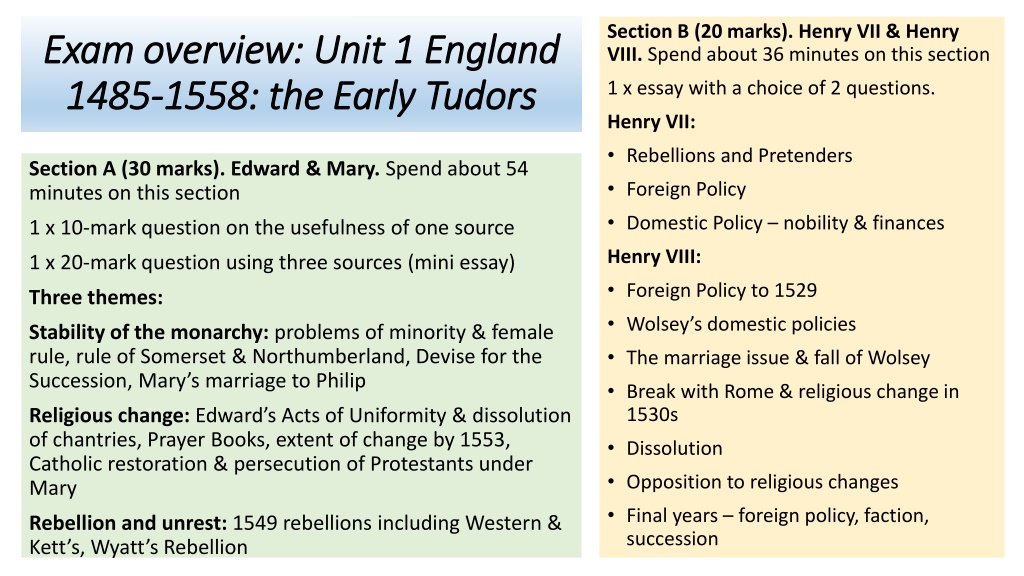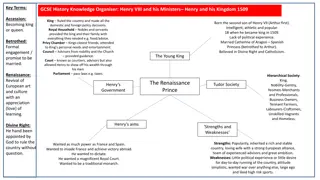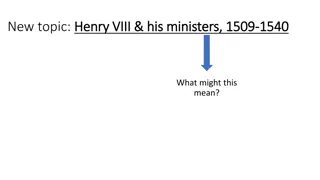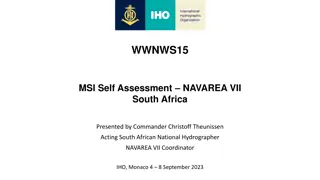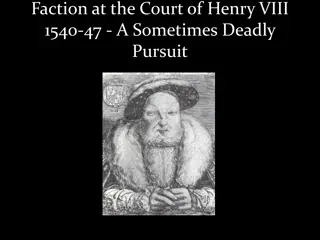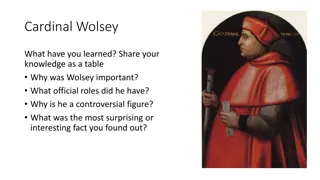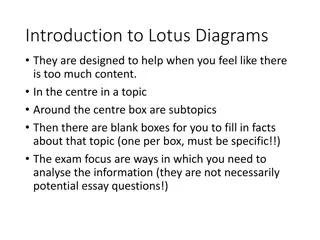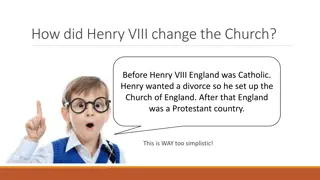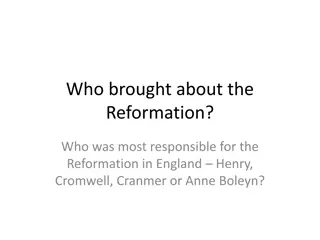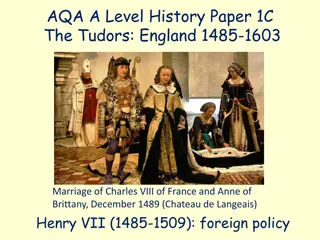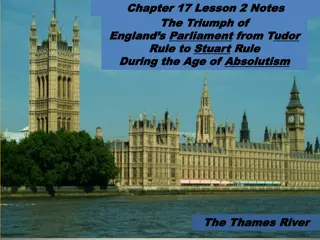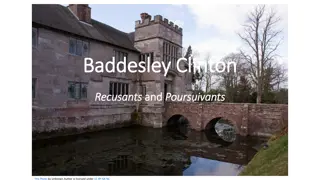Tudor Rule: Challenges and Policies of Henry VII and Henry VIII
The Tudor monarchs, Henry VII and Henry VIII, faced various challenges such as rebellions, foreign policy issues, financial management, and religious changes. This content explores the threats to Henry's rule from Yorkist challenges, the success of Henry VII's financial policies, handling of the nobility, success of Henry VIII's foreign policy, effectiveness of Wolsey's domestic policies, impact of religious changes on England becoming Protestant, and the extent of England's Protestantism by Edward VI's death in 1553.
Download Presentation

Please find below an Image/Link to download the presentation.
The content on the website is provided AS IS for your information and personal use only. It may not be sold, licensed, or shared on other websites without obtaining consent from the author. Download presentation by click this link. If you encounter any issues during the download, it is possible that the publisher has removed the file from their server.
E N D
Presentation Transcript
Section B (20 marks). Henry VII & Henry VIII. Spend about 36 minutes on this section Exam overview: Unit 1 England Exam overview: Unit 1 England 1485 1485- -1558: the Early Tudors 1558: the Early Tudors 1 x essay with a choice of 2 questions. Henry VII: Rebellions and Pretenders Foreign Policy Domestic Policy nobility & finances Section A (30 marks). Edward & Mary. Spend about 54 minutes on this section 1 x 10-mark question on the usefulness of one source Henry VIII: Foreign Policy to 1529 Wolsey s domestic policies The marriage issue & fall of Wolsey Break with Rome & religious change in 1530s Dissolution Opposition to religious changes Final years foreign policy, faction, succession 1 x 20-mark question using three sources (mini essay) Three themes: Stability of the monarchy: problems of minority & female rule, rule of Somerset & Northumberland, Devise for the Succession, Mary s marriage to Philip Religious change: Edward s Acts of Uniformity & dissolution of chantries, Prayer Books, extent of change by 1553, Catholic restoration & persecution of Protestants under Mary Rebellion and unrest: 1549 rebellions including Western & Kett s, Wyatt s Rebellion
Tasks Tasks Section A: Go onto Godalming Online, complete the timeline of Edward and Mary s reign. This will give you a reminder of the overview of the content and where it fits into each of the three themes. Plan (write?) answers to the source questions provided. One is about religion under Edward and one is about the impact of the burnings under Mary. Section B: We will be going through some key content but most of this will be you planning/ mindmapping answers to past exam questions.
How serious a threat to Henrys rule was the Yorkist challenge? How successful was Henry VII s financial policy? How successfully did Henry VII handle the nobility? How successful was Henry VIII s foreign policy 1509-1529? How successful were Wolsey s domestic policies? How far did the religious changes in Henry VIII s reign make England Protestant? To what extent was England a Protestant country by the death of Edward VI in 1553?
How serious a threat to Henrys rule was the Yorkist How serious a threat to Henry s rule was the Yorkist challenge? challenge? Serious The Stafford/Lovell rebellion in 1486 showed how insecure Henry was at the start of his reign Simnel and Warbeck were backed by Margaret of Burgundy, who financed Simnel s army at Stoke. Ireland was also sympathetic to the Yorkists. Simnel was supported by powerful nobles like Kildare, Lincoln & Lovell. Stoke was a bigger, bloodier & longer battle than Bosworth Warbeck was a threat as he received support from various times from France, Burgundy, the HRE & Scotland and Scotland invaded in 1496 leading to taxes provoking the Cornish rebellion 1497. Henry had to impose a costly & unpopular trade embargo 1493- 6 to stop Burgundy & the HRE supporting Warbeck. Henry s decisions to execute Stanley in 1495 & Warbeck in 1499 shows he did not feel secure. The imprisonment & later execution of Warwick showed he was a threat. Suffolk posed a serious threat which Henry was lucky to be able to deal with. Not serious The fact that Richard III was killed forced the Yorkists to rely on impostors. He married the best claimant Henry had more troops than Simnel at Stoke & they were more experienced. The Yorkshire tax rebellion in 1489 was not a serious threat & probably not connected to Yorkist claims to the throne anyway. Warbeck had to keep moving, successively to Ireland, Kent, France, Burgundy, the HRE, Scotland & Cornwall, reflecting his inability to get any sustained support. The Scottish invasion of 1496 was little more than a border raid & Warbeck s army in Somerset in 1497 fled without a battle. Warbeck s failure to exploit the Cornish tax rebellion in 1497 shows that it had little to do with Yorkist claims to the throne. Henry s spy network. Did the threat reduce as time went on? At what point in his reign was Henry most threatened?
How successful was Henry VIIs financial policy? How successful was Henry VII s financial policy? Move from the Exchequer to the Chamber system brought finance under his personal control. He employed effective officials like Bray, Empson & Dudley to ensure that any money due to the Crown (e.g. fines & feudal dues) was thoroughly collected. Bonds & recognisances were used to increase revenue. Income from feudal dues e.g. wardship, marriage, livery rose from 350 to 6000. Compared with Edward IV, Henry increased all revenues, especially crown lands (X4), benevolences (X2) parliamentary taxation (by 55%). Overall income was increased by 67%. He increased income from crown lands by seizing the estates of those who opposed him like Lincoln, Suffolk & Sir W Stanley. This plus Acts of Resumption (taking back all lands given away by the Crown since the Wars of the Roses started in 1455) enabled him to quadruple revenue from crown lands. He secured a French pension of 5000 in the Treaty of Etaples. He secured profitable trade agreements with Burgundy, France & Spain which boosted customs revenue. He left a substantial surplus (estimated at around 100,000) for his son. Raising taxes provoked rebellions in Yorkshire in 1489 & Cornwall in 1497, forcing Henry to limit them thereafter Trade embargoes against Burgundy 1493-6 & 1506 hampered customs revenue ( 40,000 rather than 70,000 under Ed IV) His desperation to cut off support for pretenders forced him to give huge sums to Maximilian (some estimates say around 300,000) to stop support for Warbeck & Suffolk. His greed, especially in the last years of his reign when Empson & Dudley extorted so much money by unfair methods, caused so much resentment that it might have provoked a rebellion.
How successfully did Henry VII handle the nobility? How successfully did Henry VII handle the nobility? By dating his reign to the day before the Battle of Bosworth, Henry could threaten nobles who fought against him with acts of attainder. He used bonds & recognisances to limit the power of the nobility (60% of the nobility were subjected to them at some stage during his reign) At the same time he won their support through the Order of the Garter (creating 37) He was much more effective than previous kings at penalising retaining, e.g. Burgavenny was fined 70,000 in 1507. The King s Council was used more effectively to exert control over the nobility (membership was a sign of royal trust). He relied on loyal nobles to control parts of the country, like Bedford in Wales & Oxford in East Anglia. He gained the support of some former Yorkists, e.g. Thomas Howard was restored to the earldom of Surrey for suppressing the Yorkshire tax rebellion in 1489. Hardly any nobles supported rival claimants after the Simnel rebellion; Warbeck had to rely on support from abroad. Acts of Resumption recovered land granted away since before the Wars of the Roses and using methods such as these enabled Henry to prevent the emergence of over-mighty subjects (like Warwick in Edward IV s reign). Nobles leant their support to pretenders e.g. Lincoln, Lovell & Kildare supported Simnel forcing him to fight a battle at Stoke . The failure of the nobility to prevent Simnel marching across the North in 1487 & the Cornish rebels marching across the South in 1497 shows their lack of loyalty to Henry Henry became harsher & more greedy in the 2nd half of his reign (he passed 51 acts of attainder 1504-9) despite being more secure. His excessive severity against the nobility (subjecting nearly 60% of them to bonds & recogs.) made him v unpopular. The frequency of Henry s acts against retaining (1485, 1487 & 1504) suggests they were ineffective. The limitations Henry placed on the nobility (there were only 35 nobles in England in 1509 compared with 50 in 1509) & his harshness even towards loyal supporters (he fined Oxford for retaining) made him so unpopular that there might have been a revolt if he had reigned much longer.
How successful was Henry VIIIs foreign policy 1509 How successful was Henry VIII s foreign policy 1509- -1529? 1529? Protect the dynasty: The Battle of Flodden Field annihilated the Scottish army ; the Scots posed no threat Peace with France in 1514 involved promising Henry s sister Mary to Louis XII BUT this did not last as he died and M married Charles Brandon. Henry s daughter Mary was promised to first the Dauphin and then Charles, but both engagements were broken off. Military glory: Battle of the Spurs, capturing Therouanne (1513) and Tournai. Battle of Flodden Field (1513) annihilated the Scots (but did not involve H) BUT the 1512 campaign was a failure and achieved very little; England sent an army to France in 1523, was abandoned by Charles, and the army returned in disarray, costing a year s income. A central role in European affairs/prestige: Treaty of London (1518) made England seem to be the pivotal power as 20 European countries met in London Meeting Francis I at the Field of the Cloth of Gold (1520) brought Henry prestige through its magnificence. Both Francis and Charles sought Henry as an ally in the approaching Habsburg-Valois conflict. BUT Although the Field of the Cloth of Gold was magnificent, it achieved little of diplomatic value. Following Pavia, Henry s overtures to Charles were rejected. War between Francis and Charles was ended in 1529 with the Treaty of Cambrai, and it was only at the last minute that England was invited to join the negotiations. Could also consider change over time? More successful at the start of the period, or the end? Preserve balance of power in Europe: Treaty of the More (1525) and League of Cognac (1526) aimed to try to prevent Charles V s domination of Europe. Followed by the Anglo-French Treaty of Westminster (1527) and the Treaty of Amiens. BUT Wolsey s attempt to act as a counterweight between Francis and Charles failed as the two were at war by 1521. The Battle of Pavia (1525) indicated Charles dominance in Europe: Francis army was crushed and he was captured.
How successful were Wolseys domestic policies? How successful were Wolsey s domestic policies? Legal Reform: Increased the number of cases heard in Star Chamber, Chancery & Requests so improving justice for the poor. But many of these courts could not cope with the increased caseload. Nobility: Generally had a good relationship with them he had control of patronage. But his policies alienated the nobility e.g. Eltham Ordinances 1526 restricted access of the younger nobles to Henry; interfered with their marriages Education: Dissolved small, unviable monasteries to fund a college at Oxford and school at Ipswich. But this was not true/fundamental educational reform and arguably an ego trip Raising taxes: Introduced the subsidy to replace the old system of fifteenths and tenths, bringing in far more money because it was based on a more realistic assessment of wealth. But Amicable Grant of 1525 provoked so much resistance it had to be scrapped & as a result Henry failed in France Tried to increase revenue from crown lands but in all Wolsey did not manage to raise enough money to cover the cost of Henry s foreign policy adventures Enclosures: Showed a genuine desire to help the poor by attempting to curb enclosure, with legal action taken against landowners. But it achieved no lasting success and had to be abandoned in 1523 to raise the subsidy for Henry s campaign in France He was a wealthy absentee pluralist exemplifying everything wrong about the Church and discrediting the Church in the eyes of Henry & the nobility
How far did the religious changes in Henry VIIIs reign make How far did the religious changes in Henry VIII s reign make England Protestant? England Protestant? Protestant Break with Rome (Royal Supremacy 1534) set foundations for later changes Dissolution of the Monasteries by 1540: undermined belief in pilgrimage, salvation by good works and purgatory 10 Articles (1536) rejected 4 of the 7 Catholic sacraments Royal Injunctions 1536 & 1538 criticised pilgrimage; 1538 Injunctions ordered an English Bible to be present in all parishes within 2 years. Introduction of the English Bible: Matthew s Bible 1537. English Litany published in 1544. Encouragement of Bible-based preaching. Edward VI had Protestant tutors e.g. John Cheke & a Protestant dominated Regency Council emerged by the end of the reign Not Protestant John Lambert (1538) and Anne Askew (1546) were burned for denying transubstantiation Monks & nuns still had to observe their vows of chastity despite the Dissolution. Act of the 6 Articles (1539) confirmed transubstantiation and forbade taking of communion on both kinds Act for the Advancement of True Religion 1543 restricted access to the English Bible to the upper classes & the King s defended the 6 Articles in 1543. The doctrine & worship of the Church of England was still fundamentally Catholic, with the Latin Mass, communion in one kind for the laity, transubstantiation, clerical celibacy & confession to priests still being upheld. Parish churches were barely touched & the chantries weren t dissolved. The changes were mainly legal in character with little impact on religion at grassroots level. The Pilgrimage of Grace shows how strong opposition to the Reformation in the North was. Fully Catholic, Catholic with a few Protestant elements, 50:50, Protestant with a few Catholic elements, or fully Protestant?
To what extent was England a Protestant country by the death of To what extent was England a Protestant country by the death of Edward VI in 1553? Edward VI in 1553? Protestant England was officially Protestant for the first time. 1547 Book of Homilies provided clergy with model sermons Chantries dissolved in 1547 1549 Act of Uniformity allowed clerical marriage, banned singing masses for the souls of the dead, communion in both kinds Second Book of Common Prayer (1552) established Eucharist ceremony in line with Calvin s belief in a spiritual presence . Prayers for the dead and wearing of vestments removed. Altars replaced by communion tables. Sign of cross removed in confirmation. Second Act of Uniformity (1552) enforced Second Prayer Book and it became an offence for both clergy and laity not to attend CoE services (punishable by fines and imprisonment) Forty-Two Articles (1552) Strongly Protestant. Protestant belief was strong in London, the South East & East Anglia and among people who were young, educated or involved in trade with the Netherlands or Germany. Not Protestant 1552 Act of Uniformity only lasted a year & Edward died before the 42 Articles could be imposed. Many parishes kept or hid as many images & as much church plate as they could rather than destroying them. The fact that Hooper had to urge his clergy to preach against salvation by good works, prayers for the dead, transubstantiation & the worship of saints & images suggests that such Catholic beliefs were still popular. Catholic belief was especially strong among older, less educated people in the North & West. Only 20% of the clergy married. Introduction of the First Book of Common Prayer contributed to the Western Rebellion. Rapid restoration of Catholicism under Mary suggests traditional religion remained popular.
